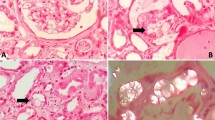Abstract
Cystine kidney stones frequently recur because inadequate prevention exists. We recruited documented recurrent cystine kidney stone formers (6 men, 4 women, 44 ± 17 years) into a 2-phased study to assess safety and effectiveness of Cystone®, a herbal treatment used to prevent and facilitate passage of cystine kidney stones. The first phase was a randomized double-blinded 12 weeks crossover study assessing the effect of Cystone® versus placebo (2 tablets BID) on urinary chemistries. The second phase was an open label 1 year study of Cystone® to determine if renal stone burden decreased, as assessed by quantitative and subjective assessment of CT. There was no statistically significant change of urinary composition from baseline short (6 weeks) or long (52 weeks) term on Cystone®, including volume (2,525, 2,611, 2,730 ml), pH (6.7, 6.7, 7.05), and cystine excretion (2,770, 2,889, 4,025 μmol). Pre and post-CT was available in nine patients. Although seven kidneys lost stones spontaneously or surgically, overall stone burden increased in seven kidneys, was unchanged in nine, and fell in only two. Quantitative scoring increased in both the left and right kidneys (1,602–1667 and 301–2,064 volumetric units, respectively). Therefore, this study does not suggest that Cystone® has a favorable effect on urinary chemistries that could decrease cystine stone formation, nor does it appear to prevent stone growth or promote stone passage over a 1-year period.


Similar content being viewed by others
Abbreviations
- AU:
-
Agatston units
- CT:
-
Computerized tomography
- GI:
-
Gastrointestinal
- mm3 :
-
Cubic millimeter
References
Calonge MJ, Gasparini P, Chillaron J et al (1994) Cystinuria caused by mutation in rBAT, a gene involved in the transport of cystine. Nat Genet 6:420
Feliubadalo L, Font M, Purroy J et al (1999) Non-type I cystinuria caused by mutations in SLC7A9, encoding a subunit (bo,+AT) of rBAT. International Cystinuria Consortium. Nat Genet 23:52
Jaeger P, Portmann L, Saunders A et al (1986) Anticystinuric effects of glutamine and of dietary sodium restriction. N Engl J Med 315:1120
Goldfarb DS, Coe FL, Asplin JR (2006) Urinary cystine excretion and capacity in patients with cystinuria. Kidney Int 69:1041
Rodman JS, Blackburn P, Williams JJ, Brown A, Pospischil MA, Peterson CM (1984) The effect of dietary protein on cystine excretion in patients with cystinuria. Clin Nephrol 22(6):273–278
Barbey F, Joly D, Rieu P et al (2000) Medical treatment of cystinuria: critical reappraisal of long-term results. J Urol 163:1419
Pak CY, Fuller C, Sakhaee K et al (1986) Management of cystine nephrolithiasis with alpha-mercaptopropionylglycine. J Urol 136:1003
Segal S, Thier SO (1983) Cystinuria. In: Stanbury JB, Wyngaarden JB, Fredrickson DS, Goldstein JL, Brown MS (eds) The metabolic basis of inherited disease, 5th edn. McGraw–Hill, New York, pp 1774–1791
Martensson J, Denneberg T, Lindell A, Textorius O (1990) Sulfur amino acid metabolism in cystinuria: a biochemical and clinical study of patients. Kidney Int 37:143
Lindell A, Denneberg T, Enestro S et al (1990) Membranous glomerulonephritis induced by 2-mercaptopropionylglycine (2-MPG). Clin Nephrol 34:108
Erickson S, Vrtiska T, Lieske J (2010) Effect of Cystone® on urinary composition and stone formation over one year. Phytomedicine (in press)
Dahlberg P, Van Den Berg C, Kurtz S et al (1977) Clinical features and management of cystinuria. Mayo Clinic Proc 52:533–542
Hollingsworth JM, Rogers MAM, Kaufman SR et al (2006) Medical therapy to facilitate urinary stone passage: a meta-analysis. Lancet 368:1171
Yencilek F, Enturhan S, Canguven O et al (2010) Does tamsulosin change the management of proximally located ureteral stones? Urol Res 38:195–199
Koide T, Yamaguchi S, Utsunomiya M et al (1995) The inhibitory effect of Kampou extracts on in vitro calcium oxalate crystallization and in vivo stone formation in an animal model. Int J Urol 2:81
Yasui T, Fujita K, Sato M et al (1999) The effect of Takusya, a Kampou medicine, on renal stone formation and osteopontin expression in rat urolithiasis model. Urol Res 27:194
Calixto JB, Santos AR, Cechinel Filho V et al (1998) A review of the plants of the genus Phyllanthus: their chemistry, pharmacology, and therapeutic potential. Med Res Rev 18:225
Atmani F, Slimani Y, Mimouni M et al (2004) Effect of aqueous extract from Herniaria hirsuta L. on experimentally nephrolithiasic rats. J Ethnopharmacol 95:87
Acknowledgments
The authors wish to thank Beverly Tietje, study coordinator; and Kathy Laabs and Joni Langowski, secretaries, for their invaluable assistance in performing the study and preparing the manuscript, respectively. Funding of the research aspects of the study (2 of the 4 duplicate urine supersaturations, pregnancy testing, and statistical analysis and all Cystone® and placebo tablets) were provided by the Mayo Foundation and Himalaya Health Care. The entire design of the study, its supervision, data analysis, manuscript preparation and decision to publish were entirely the work of the authors. None of the authors have any financial interest in Himalaya Health Care. Investigators on this study (J.C. Lieske, T.J. Vrtiska) were partially supported by the Mayo Clinic O’Brien Urology Research Center (P50 DK083007). Cystone® tablets and partial study funding were supplied by Himalaya Health Care.
Author information
Authors and Affiliations
Corresponding author
Additional information
ClinicalTrials.gov #MCT00381849.
Rights and permissions
About this article
Cite this article
Erickson, S.B., Vrtiska, T.J., Canzanello, V.J. et al. Cystone® for 1 year did not change urine chemistry or decrease stone burden in cystine stone formers. Urol Res 39, 197–203 (2011). https://doi.org/10.1007/s00240-010-0334-x
Received:
Accepted:
Published:
Issue Date:
DOI: https://doi.org/10.1007/s00240-010-0334-x




